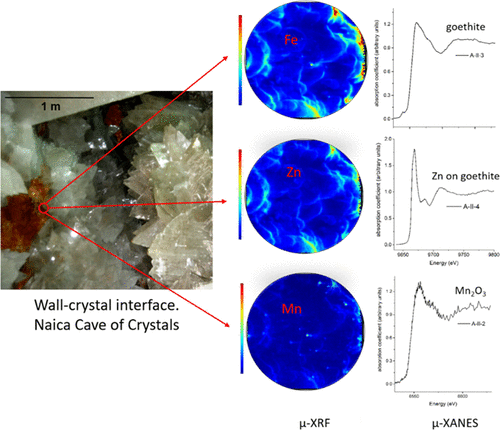当前位置:
X-MOL 学术
›
Cryst. Growth Des.
›
论文详情
Our official English website, www.x-mol.net, welcomes your
feedback! (Note: you will need to create a separate account there.)
Naica’s Giant Crystals: Characterization and Evolution of the Wall–Crystal Interface
Crystal Growth & Design ( IF 3.2 ) Pub Date : 2021-09-03 , DOI: 10.1021/acs.cgd.1c00550 Bernardo Pérez-Cázares 1 , Maria Fuentes-Montero 1 , Luis E. Fuentes-Cobas 2 , Isaí Castillo-Sandoval 2 , Iván Carreño-Márquez 2 , Hilda Esparza-Ponce 2 , Diane Eichert 3 , René Loredo-Portales 4 , Jesús Canche-Tello 2 , José Manuel Nápoles-Duarte 1 , Layla Muñoz-Castellanos 1 , Guillermo González-Sánchez 2 , Ignacio Reyes-Cortés 1 , María Elena Montero-Cabrera 2
Crystal Growth & Design ( IF 3.2 ) Pub Date : 2021-09-03 , DOI: 10.1021/acs.cgd.1c00550 Bernardo Pérez-Cázares 1 , Maria Fuentes-Montero 1 , Luis E. Fuentes-Cobas 2 , Isaí Castillo-Sandoval 2 , Iván Carreño-Márquez 2 , Hilda Esparza-Ponce 2 , Diane Eichert 3 , René Loredo-Portales 4 , Jesús Canche-Tello 2 , José Manuel Nápoles-Duarte 1 , Layla Muñoz-Castellanos 1 , Guillermo González-Sánchez 2 , Ignacio Reyes-Cortés 1 , María Elena Montero-Cabrera 2
Affiliation

|
Naica’s “Cueva de los Cristales” (Cave of the Crystals) has been compared to the most beautiful places of worship for the incredible display of columns that populate its vault. Said columns are giant gypsum crystals that have already been the subject of extensive studies. This paper contributes to these studies by focusing on the mineral aggregates found at the wall–selenite interface. A detailed chemical and structural characterization of representative samples has been performed using chemical, mineralogical, elemental, and phase analysis methods, with an emphasis on synchrotron micro-spectroscopic techniques. The following main phases were identified: calcite, silica, goethite, and several Pb-, Mn-, Cu-, and Zn-based aggregates. The role of the mineral aggregates, from their potential incorporation at the very beginning of the formation to the final steps of the crystals’ growth, is investigated. Particular attention is paid to their shapes and composition. The data obtained on the morphology of the wall–crystal interface and related phase composition, together with classical nucleation formalisms based on the slightly supersaturated solution, suggest that the nanocrystalline monomers formed in solution undergo adsorption on the wall, which ultimately promotes mega crystal growth.
中文翻译:

奈卡的巨型晶体:壁-晶体界面的表征和演化
奈卡的“Cueva de los Cristales”(水晶洞)被比作最美丽的礼拜场所,因为它的拱顶上有令人难以置信的柱子展示。所述柱是已经成为广泛研究主题的巨型石膏晶体。本文通过关注在壁 - 亚硒酸盐界面发现的矿物聚集体为这些研究做出了贡献。使用化学、矿物学、元素和相分析方法对代表性样品进行了详细的化学和结构表征,重点是同步加速器显微光谱技术。确定了以下主要相:方解石、二氧化硅、针铁矿和几种基于铅、锰、铜和锌的聚集体。矿物骨料的作用,从它们在形成之初的潜在结合到晶体生长的最后步骤,都进行了研究。特别注意它们的形状和组成。获得的壁-晶体界面形态和相关相组成的数据,以及基于轻微过饱和溶液的经典成核形式,表明溶液中形成的纳米晶单体在壁上发生吸附,最终促进了巨型晶体的生长。
更新日期:2021-10-06
中文翻译:

奈卡的巨型晶体:壁-晶体界面的表征和演化
奈卡的“Cueva de los Cristales”(水晶洞)被比作最美丽的礼拜场所,因为它的拱顶上有令人难以置信的柱子展示。所述柱是已经成为广泛研究主题的巨型石膏晶体。本文通过关注在壁 - 亚硒酸盐界面发现的矿物聚集体为这些研究做出了贡献。使用化学、矿物学、元素和相分析方法对代表性样品进行了详细的化学和结构表征,重点是同步加速器显微光谱技术。确定了以下主要相:方解石、二氧化硅、针铁矿和几种基于铅、锰、铜和锌的聚集体。矿物骨料的作用,从它们在形成之初的潜在结合到晶体生长的最后步骤,都进行了研究。特别注意它们的形状和组成。获得的壁-晶体界面形态和相关相组成的数据,以及基于轻微过饱和溶液的经典成核形式,表明溶液中形成的纳米晶单体在壁上发生吸附,最终促进了巨型晶体的生长。











































 京公网安备 11010802027423号
京公网安备 11010802027423号